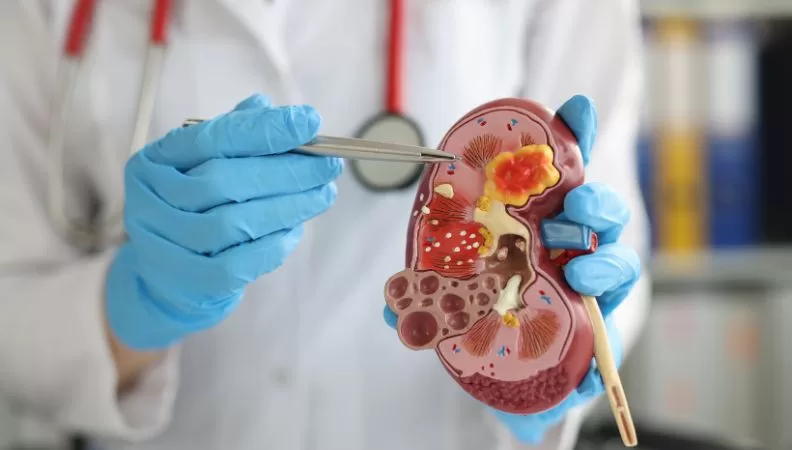Kidney Removal Surgery: Understanding the Procedure
Kidney removal (nephrectomy) is an important operation to treat various kidney-related conditions. Laparoscopic nephrectomy benefits include smaller incisions, quicker recovery, and reduced post-surgical pain. This article will explore the advantages of laparoscopic nephrectomy, along with the indications for the procedure, recovery expectations, potential complications, and cost comparisons. We will also discuss different surgical approaches, patient selection factors, and how these factors fit into the broader context of medical tourism and the latest updates from the world of healthcare.
Benefits of Laparoscopic Nephrectomy
Laparoscopic nephrectomy is preferred for its minimally invasive technique as this provides various benefits when compared to traditional open surgery:-
Reduced Pain: Smaller incisions lead to less postoperative pain compared to open nephrectomy. Patients often report a more comfortable recovery experience.
Shorter Recovery Time: Patients usually have a faster return to usual activities, with a large proportion returning to their usual daily activities within the week. For instance, a patient after a laparoscopic nephrectomy would likely be able to return to work within two weeks, whereas an open nephrectomy would take six to more weeks.
Decreased Hospital Stay: Minimally invasive procedures usually lead to shorter lengths of stay in the hospital. Patients generally require a stay in the hospital for 2-3 days after laparoscopic surgery, rather than 5-7 days after open surgery.
Lower Risk of Infection: Wounds that are smaller tend to be associated with a decreased risk of postoperative infection. This is especially relevant for immunocompromised patients.
Improved Aesthetics: The smaller incisions lead to less conspicuous scars, which can be of particular concern for patients.
These advantages render laparoscopic nephrectomy appealing to patients who are considering surgical removal of the kidney.
Indications for Laparoscopic Nephrectomy
Laparoscopic nephrectomy is indicated in various scenarios, including:-
Kidney Cancer: Laparoscopic nephrectomy is the most desirable approach for localized renal tumors because of its effectiveness and fewer complication attempts. Research indicates laparoscopic procedures can give similar oncological results as open surgery.
Non-functioning Kidneys: Such conditions as chronic pyelonephritis or renal tuberculosis may require a nephrectomy when the kidney becomes nonfunctional. Patients suffering from recurrent infections may find relief through this procedure.
Kidney Donation: Healthy subjects can also present for laparoscopic nephrectomy as a renal donation. The advantage of this method is the reduction of donor recovery time and complications and the ability to provide the recipient with healthy organs.
Obstructive Pathologies: Surgery for this condition may be indicated by hydronephrosis, or a large renal calculus, for example. Laparoscopic nephrectomy is able to alleviate symptoms and also prevent renal damage and deterioration.
The decision to perform a laparoscopic nephrectomy is based on patient factors and particular medical conditions.
Recovery and Post-operative Care
Post-operative recovery after laparoscopic nephrectomy generally involves:-
Pain Management: Patients usually receive analgesic medications to alleviate pain. Pain is reported to be controlled with over-the-counter medication once past the recovery stage.
Activity Restrictions: It is recommended that no strain activity be undertaken for a few weeks to ensure complete healing. Light walking is incentivized since it has a diuretic effect that helps promote circulation and aids in recovery.
Follow-up Appointments: A timely periodic checkup is very important for monitoring the recovery and detecting any potential complications early. Serial follow-ups may also involve imaging examinations to confirm healing and evaluate kidney function.
The overall recovery time varies but is significantly shorter than that associated with open surgery. For most patients, it is possible to resume their activities of daily living within 2-4 weeks after surgery.
Complications and Risks of Laparoscopic Nephrectomy
Despite laparoscopic nephrectomy being considered for having fewer complications than open surgery, they still come along:-
Bleeding: Bleeding may occur during or after surgery, even if less than open procedures. To reduce this risk, surgeons employ thoughtful techniques.
Infection: There remains a risk of infection at the incision sites or internally. Patients are advised on signs of infection during their recovery period.
Injury to Surrounding Organs: The procedure can cause accidental lesions to adjacent organs including the intestines or spleen. Surgeons utilize advanced imaging techniques to reduce this risk.
Conversion to Open Surgery: In certain situations, by necessity, conversion of laparoscopic procedure to open surgery has to be performed. This decision is taken according to real-time evaluation at the surgery.
Recognition of these risks is important for informed choices about kidney ablation surgery.
Cost Comparison: Laparoscopic vs. Open Nephrectomy
The laparoscopic nephrectomy can be expensive, and this can change according to factors such as setting and health care provider. In general, although laparoscopic procedures can have initially higher costs because of sophisticated features and instrumentation, they generally result in lower total costs by virtue of short hospital stays and faster recovery periods.
Cost Factors: –
Laparoscopic Nephrectomy: It normally spans from US 30,000 (depending on location and complexity). Facilities in urban locations may be more expensive to compensate for because they have higher operating costs.
Open Nephrectomy: Costs can vary from 25,000, however, are frequently associated with prolonged hospital stays as well as increased post-discharge follow-up.
Patients contemplating medical tourism for nephrectomy need to consider potential cost savings in light of travel expenses and should select accredited centers with competent surgeons.
Medical Tourism Considerations
As countries such as India, Thailand, and Mexico offer relatively inexpensive and top-notch healthcare services, they have become prominent destinations for medical tourists. Patients who undertake laparoscopic nephrectomy abroad can do so at great financial savings whilst receiving both care and expertise from experienced surgeons in member hospitals.
Laparoscopic Nephrectomy for Kidney Donation
Laparoscopic nephrectomy is more and more applied to kidney donation because of its advantages.
Minimized Recovery Time: Donors can return home sooner compared to traditional methods. There are also reports of well enough to resume light activity within a week by some donors.
Less Invasive Technique: In this method, the physical stress on the donor’s body is mitigated without compromising the treatment result for recipients. Research suggests that those who have kidneys transplanted from laparoscopically obtained organs do not report the same outcome as those who have kidneys transplanted from open surgery.
With the increasing demand for organ transplantations worldwide, this method is important for providing safe kidney donation and maintaining donor safety.
Surgical Techniques: Transperitoneal vs. Retroperitoneal
Two primary surgical approaches exist for laparoscopic nephrectomy:-
Transperitoneal Approach: –
- Access through the abdominal cavity.
- Generally allows better visualization of surrounding organs.
- Preferred most when complex cases or anticipated procedures are performed.
Retroperitoneal Approach: –
Access through the back without entering the abdominal cavity.
May decrease postoperative pain and duration of postoperative recovery, which needs to be undertaken by a single subdiscipline possessing specific competence.
Well suited for patients with a history of laparotomy, whose scars may preclude a transperitoneal approach.
The decision between these procedures depends on the surgeon’s training and the circumstances of each patient.
Robotic vs. Laparoscopic Nephrectomy
Robotic-assisted nephrectomy has been developed as a potential alternative to conventional laparoscopic approaches:-
Enhanced Precision: Robotic systems offer better dexterity and imaging of surgery that enable surgeons to have better control of delicate movements.
Potentially Reduced Complications: There are some studies indicating that robotic-assisted operations may cause fewer complications than the traditional laparoscopic technique because of the better asepsis in dissection and suturing.
Robotically guided surgery, however, can be expensive because of equipment costs, and may not be available (e.g., in all hospitals/clinics).
Patient Selection for Laparoscopic Nephrectomy
Selecting appropriate candidates for laparoscopic nephrectomy involves evaluating:-
- Overall health status
- Specific kidney conditions
- Previous surgeries or complications
Patient preferences and expectations
Careful evaluation guarantees that only likely candidates are subjected to this minimally invasive surgery. Age, body mass index (BMI), and the presence of comorbidity (such as diabetes or hypertension) are among the most important factors that affect eligibility.
Importance of Multidisciplinary Teams
In the majority of cases, the multidisciplinary team (urologists, anesthesiologists, nutritionists, and social workers) provides useful information in patient selection. This team-based strategy contributes to the best possible patient outcomes by screening all components of pre and post-operative care.
Long-term Outcomes and Follow-up Care
Long-term outcomes after laparoscopic nephrectomy are generally positive:-
The patient generally improves greatly quality of life postoperatively. Many report relief from symptoms that prompted surgery initially.
Routine follow-ups are of utmost importance for screening kidney function and management of late-onset complications. These are usually attended by blood tests, imaging studies (e.g., ultrasonography), and visits to physicians.
Evidence from studies shows that the long-term survival rate of patients undergoing laparoscopic nephrectomy benefits is comparable to those who opt for traditional open procedures. Moreover, the research indicates that with experienced surgeons, cancer recurrence rates are similar for both laparoscopic and open methods. In conclusion, laparoscopic nephrectomy benefits represent a significant advancement in kidney removal surgery. Because of these benefits, it is a promising therapy for patients with various renal disorders. As medical tourism continues to grow globally—offering access to advanced surgical techniques at competitive prices—understanding laparoscopic nephrectomy benefits will be crucial for patients in making informed healthcare decisions worldwide.



